
Today has been a busy day in Barcelona for Rachel and I, and we’re finishing today’s coverage with Samsung’s newly announced Galaxy S7 range, featuring the eponymous Galaxy S7, Galaxy S7 Edge, and a newly announced (and not very well rumoured) Gear 360 Camera as well.
The Galaxy S7 range is a reimagining of last year’s highly successful Galaxy S6 range. Samsung Australia’s Prasad Gokhale freely admits that there were things Samsung wanted to do with the S6 that it couldn’t get into the package, and having had the intervening year to revisit them, the S7 range comes with many ‘missing’ features addressed.
So, let’s see the specs:
| Galaxy S7 | Galaxy S7 Edge | |
|---|---|---|
| Screen | 5.1” Quad HD Super AMOLED 2560 X 1440 (577ppi) | 5.5” Quad HD Super AMOLED 2560 X 1440 (534ppi) Edge Screen |
| Processor | Quad core (2.15GHz Dual + 1.6GHz Dual), 64 bit, 14 nm process *May differ by markets and mobile operators |
|
| RAM | ||
| Storage | ||
| Cameras | Front: 5MP (F1.7) |
|
| Payment | ||
| Connectivity | Bluetooth® v 4.2 LE, ANT+, USB 2.0, NFC, Location |
|
| Sensors | Fingerprint, Barometer, Hall, HRM |
|
| IP Code | ||
| Battery | 3,000mAh | 3,600mAh |
| Charging | Wireless Charging compatible with WPC and PMA |
|
| OS | ||
Everything old is new again — waterproofing is back, and so are MicroSDs
Coming in three colours for the Australian market — black, gold and silver — the Galaxy S7 range features a similar design language to 2015’s range, but with many improvements. The reverse side of each phone has been refined, with curved edges for an improved in-hand feel. Having gone hands on with the devices, I can confirm that the S7 Edge is infinitely more comfortable in hand, and easier to grip, than the S6 Edge which felt, frankly, a bit sharp around the sides. The Galaxy S7 is equally much more comfortable to hold.
The camera bump has been reduced, too; instead of protruding quite significantly, Samsung have shaved it back to less than 0.5mm and the difference is really quite something. The IP rating is back too, by means of internal waterproofing rather than a need for cap plugs. We dumped the Galaxy S7 in a jar of water at the demo stand, and watched expectantly waiting for it to drown … but it just didn’t.

MicroSD is back, too, with support for cards up to 200GB. In order to incorporate the reintroduced MicroSD, Samsung have engineered a more versatile SIM tray which — for the Australian market — can be used to either a) carry two SIM cards, though its unclear whether the phone will feature two radios, or b) carry a SIM card and MicroSD card on the one tray, as shown above.
New features, going the Full Samsung
Samsung isn’t just bringing back the old features we all want back, but it’s doing some new things too. Like LG’s G5, there’s an always on display, though it works a bit differently here. Samsung uses the capabilities of its SAMOLED display to light only the pixels that need to be lit, allowing the phone to show time, calendar, notifications, battery level and more with no need to power the display on. To save power, the screen senses when its in a pocket, face down, or where the screen can’t actually be seen, and turns the always-on display off, until it’s removed from the pocket. With this, and other improvements, Samsung claims less than 1% power burn for the feature.
While we’re on displays, the Galaxy S7 will feature a compact 5.1″ display, while the Galaxy S7 Edge comes in at 5.5″ to accomodate the dual edge display. On that dual-edge display, Samsung have done a lot of work to improve the usability of the edge display, with two columns of apps or shortcuts now available on each side instead of one, and new shortcut options available for users too, including contact shortcuts and more.
2016’s Samsung camera has improved too, with the use of a nice, bright f/1.7 lens on across the range, which delivers 25% more light to the sensor, which itself has been improved with larger pixels designed to make better use of the light that arrives. This isn’t the only new trick; the Galaxy S7 camera uses every single pixel in phase detection auto-focus, meaning that instead of watching the phone camera ‘hunt’ for focus, it snaps to focus almost immediately. This is something you have to see to truly appreciate, but it is amazing, even in ridiculously low light.
Performance has had a kick in the ass too, primarily thanks to the use of new CPUs, including Qualcomm’s Snapdragon 820 and Samsung’s own Exynos processors (CPU selection varies by region). Samsung has retained its fast-charge function, but has some new tricks to keep the phone cool especially under heavy load, utilising a copper pipe heat sink to literally pipe the heat away from the processor.
2016, the year of the ecosystem — Samsung unveils the Gear 360
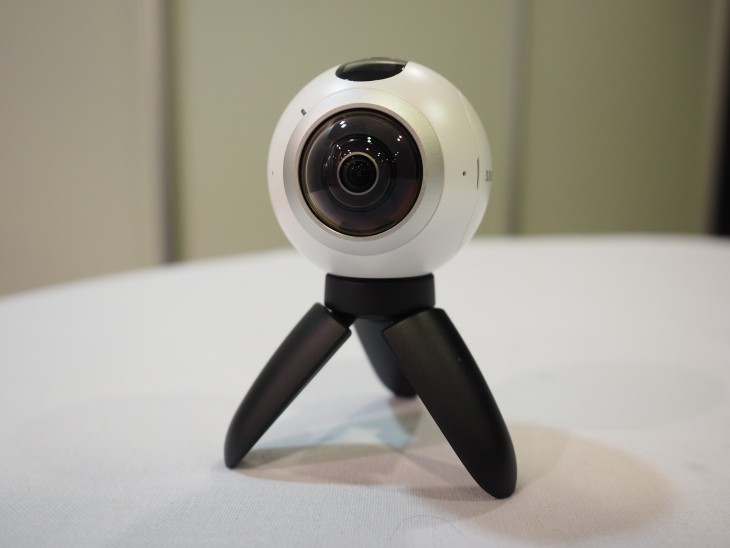
The Gear 360 is not a smartwatch, as we’ve come to associate the 360 name with (Moto 360, anyone?) Instead, it is a ridiculously cute and squid-like 360º camera that looks like something from Valve Corporation’s Portal series.
It’s not specced like a Portal turret though, so what’s inside?:
| Samsung Gear 360 | |
|---|---|
| Camera | Two CMOS 15 megapixel fisheye cameras |
| Image Processor | DRIMe5s |
| Video | MP4 (H.265) – Dual Lens: 3840×1920 (30fps) |
| Image | JPEG – Dual Lens: 30M (7776×3888) |
| Audio | Codec: MP3/AAC/AAC+/eAAC+ Format: MP3, M4A, AAC, OGG |
| Memory | microSD card (Up to 128GB) |
| Features | Display – 0.5” (72 x 32) PMOLED Shooting mode – Video, Photo, Time Lapse Video, Looping Video Camera mode – Dual/Single Lens mode Camera Setting – Sharpness, White Balance, HDR, EV, ISO limit, Wind cut IP53 Certified Dust and Water Resistant |
| Samsung Services | Samsung Gear 360 App, PC S/W (Gear 360 ActionDirector) |
| Connectivity | WiFi 802.11 a/b/g/n/ac (2.4/5GHz) WiFi Direct BT v4.1 USB 2.0 NFC |
| Sensors | Accelerometer, Gyroscope |
| Dimensions | 66.7×56.2×60 mm @ 153g (including battery) |
| Battery | 1,350mAh Li-ion |
This sexy little ball of a camera features two 180º cameras which work in unison to capture 360º of video and still frames, propped up by a built-in mini tripod that can be replaced and the camera mounted on any standard camera mounting equipment, including a possible adaptor to use any GoPro style mounts too. Each camera is 15MP, and the unit is powered by a 1,350mAh battery and MicroSD based storage. When paired with a compatible Galaxy S7 range handset, the Gear 360 can be controlled over Bluetooth, and the image data is synced to the phone for stitching of 3D photos on the go, for instant uploading to YouTube or Facebook.
The resulting images from the Gear 360 can be used in online 360º viewers (Facebook and YouTube are the notable ones), as well as Samsung’s Gear VR range. You can of course share the images via email or social media too, but the immersive 3D interactivity mightn’t be available.
Local pricing and availability
Prasad Gokhale, Vice President Mobile Division, Samsung Electronics Australia:
Quite simply, no other device like the Galaxy S7 has ever been made. With Samsung Gear VR headset and Gear 360 Camera compatibility, we have fundamentally changed what a mobile device can offer. Meaningful innovation should deliver beautifully crafted technology that is built to support the lifestyles of today’s consumer.
So. Where do you get it and how much? Surprisingly Samsung has answers to these questions, advising that the Galaxy S7 and Galaxy S7 Edge will be available for pre-order in Australia on the 26 February with devices going on-sale on the 11th of March. Pricing for the phones start at $1,149 RRP for the Galaxy S7 and $1,249 RRP for Galaxy S7 edge.
As a pre-order bonus, Samsung will be offering a Samsung Gear VR headset to anyone in Australia who pre-orders the Galaxy S7 and Galaxy S7 Edge from a participating retailer between the 26th of February and the 10th of March.
The Samsung Gear 360 camera will also be coming to Australia, but later in the year. Samsung will be announcing pricing and availability for the Gear 360 camera closer to the local launch date.



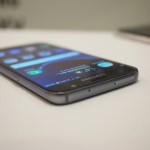






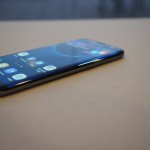
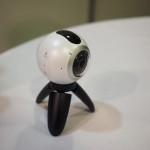
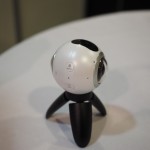
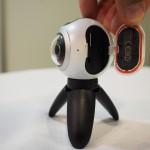



Do we get the Exynos or the Snapdragon?
Yet to be confirmed.
Chris, please offer a declaration like all other Aussie media on the junket-train to MWC, under these articles AUSDROID should be openly stating it travelled to MWC as a guest of (insert company name here). If it’s good enough for the other journalists it’s good enough for AUSDROID.
Hi Andrew. I believe they should declare that with the company they have travelled with on their posts, but not for others. Where are your press credentials for your ethics?
Andrew, it is common practice to declare who paid for your trip when discussing your sponsor. It is rare for journalists to say “Company X flew me” when discussing Company Y; in fact, very few people here would be going to that extent.
We travelled as guests of Huawei, and that has nothing to do with LG or Samsung, so why would we ‘disclaim’ that here?
Is the Gear VR the same as model that was used with the Galaxy S5/S6/edge, or is it a new one to go with the S7?
From what I can tell, it LOOKS like the same model.
Gee that camera sounds good. I’m looking forward to the comparisons coming soon.
> Pricing for the phones start at $1,149 RRP for the Galaxy S7 and $1,249 RRP for Galaxy S7 edge.
Ha ha ha ha ha ha ha ha ha ha ha ha ha ha ha ha ha ha ha ha ha ha ha …….
The plummeting AUD has a lot to answer for.
Only seemed like yesterday the S6 came out.